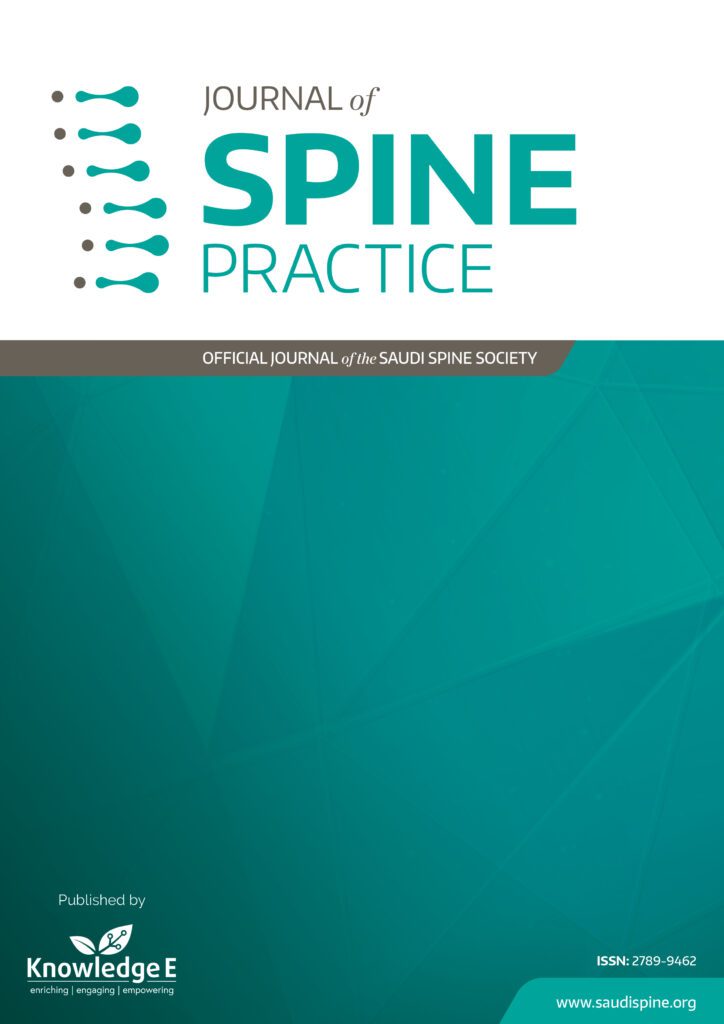
Journal of Spine Practice
ISSN: 2789-9462
Leading research in all spine subspecialties focusing on orthopaedic spine, neurosurgery, radiology, and pain management.
Three decades of spine surgery research evolution in Saudi Arabia: A bibliometric analysis
Published date:Jul 04 2023
Journal Title: Journal of Spine Practice
Issue title: Journal of Spine Practice (JSP): Volume 2, Issue 2
Pages:51 - 60
Authors:
Abstract:
Background: Over recent decades, there has been a constant increase in the numbers and quality of spine surgery research. We herein plan to analyze the evolution of spine surgery-related publications from Saudi Arabia for three decades.
Materials and Methods: A systematic review of the literature with predefined inclusion criteria was carried out, utilizing multiple significant databases (PubMed, Google Scholar, and Embase). Multiple search terms were used to retrieve related articles. Numerous variables were collected and analyzed, such as articles’ level of evidence, citation numbers, study design, and author-related information. For comparison, the study period was divided into three time frames: 1990–2000, 2001–2010, and 2011–2022.
Results: Out of 2969 articles, only 254 met the inclusion criteria of the current study. During the period 2011–2022, an increase of 41% was observed in the number of publications. The highest number of publications was in 2020 (n = 36, 14.2%). Level IV comprised the highest percentage (n = 130, 51%). High-quality articles (Levels I and II) had increased (11%) from 2011 to 2022. The most commonly utilized study design was case reports (44%). Seven randomized controlled trials were identified during the study period. Most of the included articles were from Riyadh province (65%). Research interest revolved around general spine care, trauma, and oncology in 2011–2022.
Conclusion: This is the first study to quantitatively analyze spine surgery-related research in Saudi Arabia. However, there has been significant development in several publications in the last decade, but the quality still needs to be improved. Therefore, we should aim to produce higher-quality studies to meet the country’s 2030 vision goals to be one of the leading nations in spine surgery practice.
Keywords: Spine surgery, Bibliometric, Quality, Evolution, Saudi Arabia, Neurosurgery, Orthopedics
References:
[1] Rosales RS, Reboso-Morales L, Martin-Hidalgo Y, Diez de la Lastra-Bosch I. Level of evidence in hand surgery. BMC Res Notes 2012; 5: 665.
[2] Jamjoom BA, Jamjoom AA, Jamjoom AB. Level of evidence of clinical neurosurgery research in Saudi Arabia. Neurosciences 2014; 19(4): 334–337.
[3] Dong F, Fan M, Jia Z. Fifty top-cited fracture articles from China: A systematic review and bibliometric analysis. J Orthop Surg Res 2016; 11(1): 71.
[4] Falavigna A, Botelho RV, Teles AR, da Silva PG, Defino HL. Assessing the evolution of publications by Brazilian spine surgeons in the last decade. Eur Spine J 2013; 22(9): 2084–2088.
[5] Falavigna A, Botelho RV, Teles AR, da Silva PG, Martins D, Guyot JP, et al. Twelve years of scientific production on Medline by Latin American spine surgeons. PLoS One 2014; 9(2): e87945.
[6] Kanna RM, Falavigna A, da Silva PG, Quadros FW, Merlin LH, Radaelli L, et al. Trends in scientific publications of Indian spine surgeons over 14 years (2000-2013). Indian J Orthop 2016; 50(3): 322–326.
[7] Kawaguchi Y, Guarise da Silva P, Quadros FW, Merlin LH, Radaelli L, Guyot JP, et al. Analysis of scientific output by spine surgeons from Japan: January 2000 to December 2013. J Orthop Sci 2016; 21(1): 13–18.
[8] Lee SE, Jahng TA, Kim KJ, Hyun SJ, Kim HJ, Kawaguchi Y. Research articles published by Korean spine surgeons: Scientific progress and the increase in spine surgery. J Clin Neurosci 2017; 36: 6–11.
[9] Si G, Liu X, Xu N, Yu M, Liu X. A 14-year literature survey on spine-related clinical research output by orthopedic surgeons from mainland China. Medicine 2018; 97(34): e11959.
[10] Jamjoom AB, Gahtani AY, Sharab BM. Regional variation in the neurosurgical workforce in Saudi Arabia. Cureus 2022; 14(8): e28236.
[11] Baeesa S, Maghrabi Y, Bajoh S, Bajammal S. Assessing the evolution and level of evidence of spine surgery research in Saudi Arabia. J Health Serv Res Policy 2018; 6: 52.
[12] Baeesa SS, Maghrabi Y, Msaddi AK, Assaker R. Quality of spine surgery research from the Arab countries: A systematic review and bibliometric analysis. Biomed Res Int 2017; 2017: 7560236.
[13] Al Faraj S, Al Mutairi K. Vitamin D deficiency and chronic low back pain in Saudi Arabia. Spine 2003; 28(2): 177–179.
[14] Bin Abdulrahman AK, Aldayel AY, Bin Abdulrahman KA, Rafat Bukhari Y, Almotairy Y, Aloyouny S, et al. Do Saudi medical schools consider the core topics in undergraduate medical curricula? BMC Med Educ 2022; 22(1): 377.